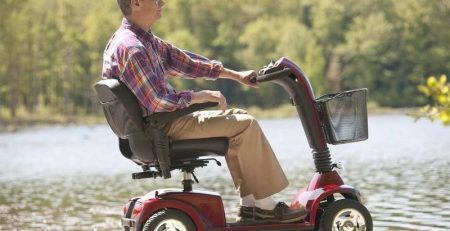- No products in the cart.
Wheelchair or Mobility Scooter: Which is Best for You?
A discussion about the differences between wheelchairs and mobility scooters to help aid mobility.
When faced with specific medical conditions that threaten our mobility, our minds will often wonder how we will exhibit our freedom for getting around.
You may worry that as a result of our disability or mobility issues that you are forced to spend your life inside.
However, thanks to specially designed equipment to those who face the challenges of immobility, they have various options to help them to move around independently.
If you suffer with limited mobility, there are a wide variety of options that are available for people who want to find ways to enjoy the freedom of being able to move around easily on their own terms.
Wheelchairs and mobility scooters are what comes to mind for people who for various reasons find walking challenging.
But how do you choose between an Electric Mobility Scooter and a wheelchair to help to aid mobility?
In order to make the right decision for you, you first need to understand the key differences between the two pieces of mobility equipment. You can then determine how these differences will suit your individual needs.
Why Do People Use Mobility Aids?
Most people don’t ever think about a day when they won’t have their mobility or independence to get around. However, when faced with critical illness following an accident, deterioration in mobility due to age or disability, you are then faced with a decision.
Physical independence is key to getting people to achieve that sense of meaning and identity. It is believed that strong, able bodied people are best when it comes to contributing to family life or society as a whole. The sense of losing this can be detrimental to one’s overall sense of self worth.
While some mobility issues cause unavoidable barriers to independence, there are certain means to gain a sense of independence which are adapted to suit the needs of the individual.
This is where the use of suitable mobility equipment can be used to help aid people who have physical disabilities and/ or mobility issues.
What is a Wheelchair?
When it comes to thinking of wheelchairs, people will often think about the cloth chairs that attach to a frame with wheels. They are commonly used in shopping malls, airports, and hospitals for people who experience difficulty walking through these spaces. However, while the design of the traditional wheelchair hasn’t altered too much over the years, there are many new features which make the usage much more comfortable.
Additionally, electric powered wheelchairs are high-tech with a wide range of advanced features that are used to aid mobility and independence.
These chairs have between 4 and 5 wheels and are steered with a hand controlled joystick, which means that unlike traditional wheelchairs, they can be used without needing additional support of somebody pushing them around.
Pros and Cons of Using a Wheelchair
Electric powered wheelchairs, also known as Power Chairs are easy to move around on indoor flooring and sidewalks and terrain outside.
Unlike traditional wheelchairs, these electric wheelchairs can offer a huge range of electric aid to the user by including motorised tilt, recline, and stand functions which make them much more comfortable for users with a range of mobility and posture issues for extensive use over long periods.
Traditional wheelchairs are good for carers who need to take more control over the transportation of those they are caring for. They make daily activities much easier and safer for both parties. They are foldable which makes taking them into a car much easier for transporting wheelchair users into a standard vehicle.
However, electric wheelchairs are very heavy- which, although means they have the stability and durability needed, it also makes transporting them incredibly difficult. They do not fold which means having to use an adapted vehicle to transport them which can also handle their weight.
Their heavy weight also makes them too heavy for use on lifts and trailers.
They do, however, come with four-point tie downs which help to keep the wheelchairs and wheelchair users safe and secure in a moving vehicle.
Wheelchairs and power chairs do, naturally, vary wildly in cost, depending on their features.
Wheelchairs start at around $350-$1,200 and Power chairs cost anything from $2.400 to $15,000.
What is An Electric Scooter?
An electric, or mobility scooter allows people with mobility issues to travel around independently both inside the home and while out and about. These medical scooters have a wide range of users from travel on rough surfaces to navigating your way through tight corners, such as in stores and throughout the home.
They can be categorised into three different types
- The 3 Wheel Mobility Scooter, which can offer a tighter turning radius and has more room for people with longer or stiff legs.
- The 4 Wheel Mobility Scooter, which can support weights up to 227 Kilos, so is an ideal solution for people with obesity related immobility.
- The Compact Mobility Scooter, the smaller option which can be folded or dismantled before being placed in the car. They are a good option for those who have limited storage space in the home as they can be stored and kept hidden away in smaller spaces.
Pros and Cons of Using A Mobility Scooter
With a wider range of options, mobility scooters tend to be more diverse in their offerings.
One of the main advantages of using a mobility scooter is that they are easy to transport. When broken down into 3-5 pieces they can fit fairly easily into most people’s cars.
They are, however, sometimes more difficult to get in and out of as the platform can be a little confusing for older people when trying to reach the ground. They also require a lot more foot navigation for getting up.
Another advantage of mobility scooters is that they look less like medical equipment. Their ability to maneuver over a range of terrain is that they are more fun to use. This gives people with mobility issues more fun and freedom. They also have baskets which can be used for additional storage and can be made personal to the user.
However, they will need a lot more space to turn around in- even the compact option, which could be problematic for some.
As far as mobility equipment goes, mobility scooters are significantly less expensive, as they cost between $1,400 and $9,000.
Can I Use Both A Wheelchair and a Scooter?
There are some features that wheelchairs and mobility scooters have in common when it comes to being a good choice of mobility vehicle.
An example of this is that power wheelchairs and mobility scooters both run from a similar battery, which can run for around 15 miles before needing to be recharged, which is great for long trips out without needing to be pushed in a manual wheelchair by another person. The speed controls are both very similar and simple to navigate, too.
They can both carry up to 500lbs or 227 kilos in weight making them a good option for people suffering with weight-related immobility.
There are advantages and disadvantages of using both an electric power chair and a mobility scooter, but using one or the other alongside a traditional wheelchair may prove to have advantages such as being a good back up for when the batter on the electric chair is running low.
Wheelchair or Mobility Scooter: Which is Best For You?
When considering your best options, there are a number of things that will need to be accounted for- these are: cost vs features, the general usage of your mobility equipment, and the type of space and or vehicle you have.
Mobility scooters are the cheaper option in comparison to electric wheelchairs, but manual wheelchairs are the cheapest option still.
When considering the transportation of your personal mobility vehicle, a mobility scooter can be folded or disassembled to fit easily into a vehicle, or carried behind a car in a trailer. Most electric power chairs are far too heavy and bulky to be able to do this.
However, adapted vehicles can cope with the weight of a person and electric power chair just fine with additional safety features which mean they can be transported much easier in these types of vehicle than a mobility scooter.
Ultimately, the choice between a wheelchair and a mobility scooter will come down to its intended use and the level of support you will be getting while out.
If you will be using your vehicle for running errands and taking public transport, if you want to explore the great outdoors, or if your level of mobility allows it, a mobility scooter is a good choice for you.
If you’re getting support from others while out and around the home, a wheelchair and or power chair may be a good choice for you.
Soon, you will be able to draw your own conclusions as to which is the best option for you.
For a wide range of products and advice, check out our range of mobility aids by clicking here.














